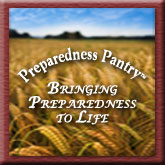
My husband grew up in the San Francisco Bay area, and I lived there for a decade. We both enjoy sourdough (SD for short) bread, but are VERY picky about what we would call sourdough. There are a lot of SD wanna-be's out there. There are also a lot of folks that would be happy to sell you the definitive SD starter for only $19.99, $29.99 or more. Do not be fooled!!
Having been in search of great SD in the decade since I left San Fran, there are a few things I can pass along. First, your SD starter, unless you live in San Francisco or Seattle will never taste like the stuff from the Boudin Bakery (my FAVORITE) at Fisherman's Wharf. The reason is simple: you do not have a daily dose of thick fog that keeps the variety of microbes in the SF Starter happy. You can approximate that flavor, and I will share that tip with you a few paragraphs from now.
Second, the two best starters I have ever used are FREE. OK, close to free. For one, a couple of postage stamps are involved. For the other, you will need a pound of red grapes. Crazy, isn't it!?
If you have never kept a sourdough starter, there are three basic rules: 1. Do not use anything metal to store or proof your SD starter. 2. This is alive, like having a pet. If you can't commit to the starter and feed it weekly once it is going, don't start it. 3. Be consistent with your flour and water for the best product. If you must use tap water, let it stand for at least 12 hours before you add it to the starter.
Once you commit, you need about 10 pounds of flour for the process during the first month or two. Do not use finely milled flour. I have used gold medal all-purpose and King Arthur unbleached bread flour successfully. WalMart Hungarian flour, which I love and use for other things, does not work well for starter. It is too fine.
Now, let's start with the grape method. Get access to a copy of either the first COOKING WITH MASTER CHEFS by Julia Child, or BREADS FROM LA BREA BAKERY by Nancy Silverton. You can probably find them without buying. Basic concept is to use the natural yeast on the grapes as they team up with the natural ones in your flour.
Basic process is to start with 1 to 2 pounds of grapes stems and all, unwashed, wrap in cheese cloth, tie in string so you have a bundle, smack it a few times with a rolling pin to rough up most of the grapes and release the grape juice and sugars onto the cheesecloth. Drop your battered bundle into a large glass bowl, add 3 cups of water and a cup or so of flour - enough to cover the bundle. Put a plate over the top and leave it on the counter over night. Feed it the next day, but this time, about 1.5 cups of water and 1 cup of flour. Mush the bundle with a wooden or plastic spoon a few times to circulate the goods inside the cheesecloth. Two days later, 1 cup of each and mush the bundle. There should be good bubbles by now, and it should smell a bit like wine. Two more days, 1 cup of each and mush. Two days later, remove the grape bundle (Mush the goods out with clean hands as you remove) and pour the starter in the glass jar. Feed it with equal parts flour and water and put it in the fridge. Use whatever doesn't fit in the jar to make bread or pancakes. To keep my starter in the fridge, I use a 2 quart glass jar with a rubber ring and top. Not sure what you call these, but they have the metal fittings to keep jar and top attached. I buy wonderful Italian ones from Ross, where they are very inexpensive.
Now that you are familiar with the hard way to make your own, here is the EASY method. Go to the Friends of Carl website ( http://carlsfriends.net/ ) and follow the directions to send them a self-addressed stamped envelope. They will send you a dried version of a wonderful heirloom starter that has been passed around and preserved since 1847! When you get the dried starter, follow the directions to revive it. Put the left over dried starter in a cool place, or the freezer, in case you need it later. It is the best!! Once you have a good quart or two grown on your counter, you are ready to make some SD bread and pancakes and store the remainder in the fridge! Now, go forth. May your wild yeasts be fruitful and multiply!
If you want to give your bread more of the San Fran taste, you need to replicate the other organisms that are present in the SF starters. My best result to do this is to add 2 to 4 ounces of Dannon non-fat plain yogurt to a cup or two of the starter when I begin to bake. DO NOT ADD to your jar of starter!! I also add about half a teaspoon of commercial yeast to the loaf. Again, not to your jar of starter. Either of these live commercial organisms (from the yogurt and yeast) will out-compete your delicate wild starter yeasts and you will lose the delicious flavor it brings if you add them to your 'mother' starter in the big jar in the fridge. That process does not happen fast enough to kill the flavor of one batch of bread, so you are OK there. I also use only starter as the liquid for my bread so that I do not need to let it grow overnight to leaven the bread. Throwing in an extra tablespoon of sugar to give the yeast some PEP is also helpful.
If you use a bread machine, do not use the short or quick cycle or your wild yeasts will not have a chance to do their thing. By hand, lengthen your rise time to get a full rise. Your ovenspring will also be somewhat less than with commercial yeast.
As for care and feeding: I bake weekly, but only use the SD every two weeks. I feed it weekly with a cup each of water and flour. I keep it in the refrigerator to slow the growth so that it does not eat me out of house and home, or become weak from hunger.
If you decide you love SD, treat yourself to Nancy Silverton's book. It is fabulous and shows how you could spend your life becoming a SD gourmet!
If you have a favorite sourdough starter or bread recipe, please share by using the comments process below!




No comments:
Post a Comment